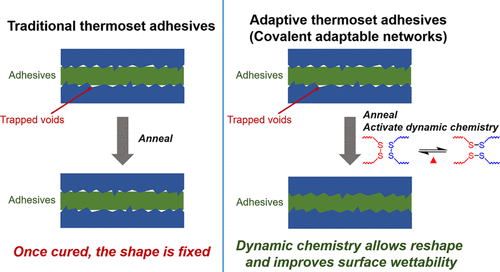当前位置:
X-MOL 学术
›
ACS Appl. Polym. Mater.
›
论文详情
Our official English website, www.x-mol.net, welcomes your
feedback! (Note: you will need to create a separate account there.)
Covalent Adaptive Networks for Enhanced Adhesion: Exploiting Disulfide Dynamic Chemistry and Annealing during Application
ACS Applied Polymer Materials ( IF 4.4 ) Pub Date : 2020-09-02 , DOI: 10.1021/acsapm.0c00720 Lingqiao Li 1 , Xi Chen 1 , John M. Torkelson 1, 2
ACS Applied Polymer Materials ( IF 4.4 ) Pub Date : 2020-09-02 , DOI: 10.1021/acsapm.0c00720 Lingqiao Li 1 , Xi Chen 1 , John M. Torkelson 1, 2
Affiliation

|
During the curing process of traditional thermoset adhesives/sealants, it is impractical to avoid all nonideal conditions, e.g., preassembly reactions, trapped voids, and polymerization-induced shrinkage, which may lead to the accumulation of internal stress and poor surface wetting and result in severe, permanent detrimental effects on adhesive/sealant performance. In order to address these issues and improve performance, we have developed a simple method using dynamic chemistry to achieve adaptable thermoset adhesives/sealants. Specifically, by incorporating dynamic chemistry into the polymer network structure, the resulting thermoset adhesives/sealants gain the capability to change their shape upon a stimulus, e.g., heat, to fill voids and release internal stresses generated during the curing process, leading to enhanced surface wettability and superior adhesive performance. We describe in detail an example of such materials based on simple disulfide dynamic chemistry and application methods. After annealing, the dynamically cross-linked adhesives exhibited a factor of ∼4 increase in lap shear strength in comparison with as-cured samples that were not annealed and a factor of 2 increase in lap shear strength when compared to an annealed control adhesive system utilizing permanently cross-linked materials. These results indicate that adaptive thermoset adhesives can be utilized to overcome major problems associated with traditional thermoset adhesives, e.g., unsatisfactory surface wetting and accumulated internal stresses. Given the simplicity of incorporating dynamic chemistries, adaptive thermoset adhesives are promising candidates for future adhesives/sealants with superior performance.
中文翻译:

共价自适应网络以增强粘附力:在应用过程中利用二硫化物动态化学和退火
在传统热固性粘合剂/密封剂的固化过程中,避免所有非理想条件(例如预组装反应,陷留的空隙和聚合引发的收缩)是不切实际的,这可能导致内部应力的累积和不良的表面润湿性并导致对胶粘剂/密封剂性能的严重,永久性有害影响。为了解决这些问题并提高性能,我们已经开发了一种使用动态化学的简单方法来实现可适应的热固性粘合剂/密封剂。具体而言,通过将动态化学过程纳入聚合物网络结构中,所得的热固性粘合剂/密封剂具有在刺激(例如加热)下改变其形状的能力,以填充空隙并释放固化过程中产生的内部应力,导致增强的表面润湿性和优异的粘合性能。我们将基于简单的二硫化物动态化学和应用方法详细描述此类材料的示例。退火后,与未退火的固化样品相比,动态交联胶粘剂的搭接剪切强度提高了约4倍,搭接剪切强度提高了2倍。永久性交联的材料。这些结果表明,可以利用自适应热固性粘合剂来克服与传统热固性粘合剂相关的主要问题,例如,不令人满意的表面润湿和累积的内应力。鉴于结合动态化学方法的简便性,
更新日期:2020-09-02
中文翻译:

共价自适应网络以增强粘附力:在应用过程中利用二硫化物动态化学和退火
在传统热固性粘合剂/密封剂的固化过程中,避免所有非理想条件(例如预组装反应,陷留的空隙和聚合引发的收缩)是不切实际的,这可能导致内部应力的累积和不良的表面润湿性并导致对胶粘剂/密封剂性能的严重,永久性有害影响。为了解决这些问题并提高性能,我们已经开发了一种使用动态化学的简单方法来实现可适应的热固性粘合剂/密封剂。具体而言,通过将动态化学过程纳入聚合物网络结构中,所得的热固性粘合剂/密封剂具有在刺激(例如加热)下改变其形状的能力,以填充空隙并释放固化过程中产生的内部应力,导致增强的表面润湿性和优异的粘合性能。我们将基于简单的二硫化物动态化学和应用方法详细描述此类材料的示例。退火后,与未退火的固化样品相比,动态交联胶粘剂的搭接剪切强度提高了约4倍,搭接剪切强度提高了2倍。永久性交联的材料。这些结果表明,可以利用自适应热固性粘合剂来克服与传统热固性粘合剂相关的主要问题,例如,不令人满意的表面润湿和累积的内应力。鉴于结合动态化学方法的简便性,










































 京公网安备 11010802027423号
京公网安备 11010802027423号